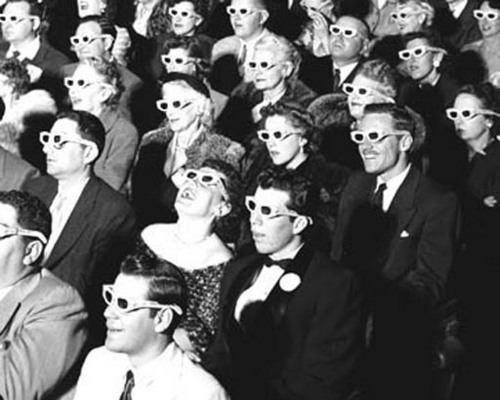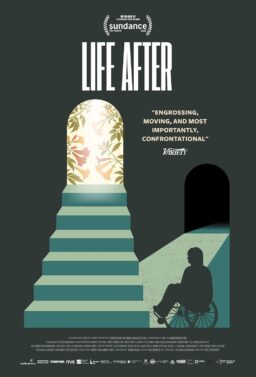As it happens, I missed the press preview for “Fly Me to the Moon.” It was a stupid misunderstanding, too boring to describe. My fault. I admit I was not inconsolable. After “Space Chimps,” I had launched enough animated creatures to the Moon without starting on the insect kingdom. But even more to the point, “Fly Me to the Moon” was in 3-D, and I could all too easily imagine being “startled” by flies buzzing, ohmigod! straight at me!
Faithful readers will know about my disenchantment with 3-D. My dad took me to see the first 3-D movie, Arch Oboler’s “Bwana Devil,” in 1952. Lots of spears thrown at the audience. Since then I have been attacked by arrows, fists, eels, human livers, and naked legs. I have seen one 3-D process that works, the IMAX process that uses $200 wrap-around glasses with built-in stereo. Apparently that process has been shelved, and we are back to disposable stereoscopic lenses, essentially the same method used in 1952.
There seems to be a belief that 3-D films are not getting their money’s worth unless they hurtle objects or body parts at the audience. Every time that happens, it creates a fatal break in the illusion of the film. The idea of a movie, even an animated one, is to convince us, halfway at least, that that we’re seeing on the screen is sort of really happening. Images leaping off the screen destroy that illusion.
There is a mistaken belief that 3-D is “realistic.” Not at all. In real life we perceive in three dimensions, yes, but we do not perceive parts of our vision dislodging themselves from the rest and leaping at us. Nor do such things, such as arrows, cannonballs or fists, move so slowly that we can perceive them actually in motion. If a cannonball approached that slowly, it would be rolling on the ground.

In common with most species, we have excellent perception of movement. The first rudimentary “eyes” evolved to sense the difference between light (the source of energy) and darkness (its absence). Very slowly those early cells developed an ability to sense motion. The notion that eyes had to be an example of “intelligent design” is flawed because it cannot imagine an eye evolving toward what it cannot conceive. But sight has evolved independently dozens of times on this planet, growing more complex not because it what it was evolving into, but because of what it was evolving away from: less perception of light and movement. Those few creatures who because of chance mutation gained an advantage were of course more likely to survive.
Our ancestors on the prehistoric savannah developed an acute alertness to motion, for the excellent reason that anything that moved might want to eat them. Movement perceived against a static background is dominant, a principle all filmmakers know. But what about rapid movement toward the viewer? Yes, we see a car aiming for us. But it advances by growing larger against its background, not by detaching from it. Nor did we evolve to stand still and regard its advance. To survive, we learned instinctively to turn around, leap aside, run away. We didn’t just stand there evolving the ability to enjoy a 3-D movie.
There were a lot of perceptive comments about my recent blog entry, “The Effect of Effects.” The consensus seems to be that, in most cases, not all, those effects are best that don’t seem obvious. The contrast was drawn between the cartoon-like movements in the first “Spider-Man” and the far superior integration of the effects in “Spider-Man 2” and “The Dark Knight.” Even obvious effects can be made convincing; witness the readers who became emotionally involved in the final battle between the iron machines in “Iron Man.” Of course you knew they were effects. But the staging and situation had been so carefully prepared that in a way you believed in the two creatures, and cared about what happened.
In my review of the 3-D “Journey to the Center of the Earth,” I wrote that I wished I had seen it in 2-D: “Since there’s that part of me with a certain weakness for movies like this, it’s possible I would have liked it more. It would have looked brighter and clearer, and the photography wouldn’t have been cluttered up with all the leaping and gnashing of teeth.” “Journey” will be released on 2-D on DVD, and I am actually planning to watch it that way, to see the movie inside the distracting technique. I expect to feel considerably more affection for it.
Ask yourself this question: Have you ever watched a 2-D movie and wished it were in 3-D? Remember that boulder rolling behind Indiana Jones in “Raiders of the Lost Ark?” Better in 3-D? No, it would have been worse. Would have been a tragedy. The 3-D process is like a zombie, a vampire, or a 17-year cicada: seemingly dead, but crawling out alive after a lapse of years. We need a wooden stake.
* * *
Postscript. I have witnessed a believable 3-D illusion. It was at a ShoWest demonstration of Douglas Trumbell’s doomed Showscan. He projected 70mm film at 60fps. It created the illusion of depth not by leaving the screen but by seeming to recede within it. It was like looking through a window and seeing the perspective of reality. You may have seen it being used in thrill rides at Disneyland. It was too expensive for theatrical films. A more affordable process, MaxiVision, creates its illusion with 35mm at 48fps. But Hollywood is profoundly conservative and shy of technical innovation; it embraced HD video because it provides an approximation of what they’re used to. Once on a panel at Sundance, I asked an obvious question: Why does HD approximate the film standard of 24 fps, or the TV standard of 30fps, when it could just as easily approximate 60 fps? None of the experts had an answer.
-30-












